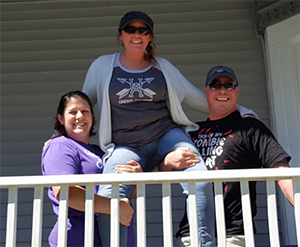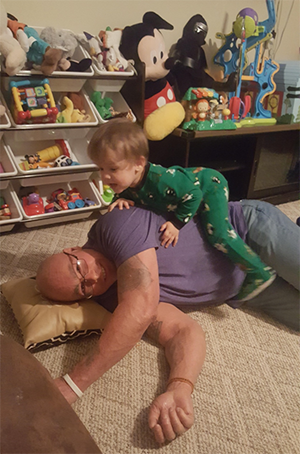Banishing back pain, spinal cord stimulator got Andrew DeAngelis off the couch and onto the racetrack.

Five years ago, Andrew DeAngelis’ life had ground to a halt because of his chronic back pain. Previously active, he had become overweight, depressed and virtually immobile, relying on a cane to get around. “Most of the time I couldn’t get off the couch. I don’t think there was a single day it didn’t hurt to get out of bed,” he says. “I was on all kinds of pain medication, and nothing seemed to be working.”
Chronic pain is one of the most complex conditions for doctors to treat effectively. Patients experience chronic pain very differently, and it’s hard to find treatment options that completely eliminate pain. Chronic pain can drastically limit a person’s day-to-day ability to move, work or sleep, which can often lead to further physical deterioration and depression.
A trial run
DeAngelis’ quest for new treatment options brought him to the office of Dr. Nandan Lad, where he says he immediately felt he was in the right hands.
“He listened to everything I said and treated what I was explaining to him, not what he thought he should be treating,” he explains. “I liked that.” He also appreciated how communicative and helpful Physician Assistant Beth Parente was. “I love Beth to the moon and back.”
Dr. Lad suggested a spinal cord stimulator, an implanted device that intercepts pain signals before they reach the brain. DeAngelis was initially skeptical, but when he heard that he could “test drive” a temporary spinal cord stimulator for a few days, he agreed.
After a quick procedure, his world changed. “I was able to walk around, for the first time in eight years, without a cane, without worrying if I was going to fall down and be able to get back up,” he says.
Going the distance
He decided to have the spinal cord stimulator permanently implanted. The surgery was uneventful, but what happened afterward was not. “I got to walk out of the hospital. I wasn’t wheeled out in a wheelchair, I walked of my own volition, and that felt great,” he recalls.
The device took some getting used to. Spinal cord stimulators work by replacing pain signals with a different feeling, which some people describe as a tingling or gentle massaging sensation. But the dramatic reduction in pain inspired DeAngelis to make another major change in his life—to become fit again.
Little by little, he resumed weightlifting and eventually started running, something he’d never done before. After a few years with the spinal cord stimulator, he had even worked his way up to running marathons. “I wasn’t the fastest guy, not by any means—but I didn’t care,” he says. “Just a few years before, I could barely get up and walk across a room.”
He also resolved to take better care of himself overall, eating more nutritious food and carefully planning workouts to maximize health and minimize pain and injury. “The spinal cord stimulator was the catalyst I needed. It allowed me to manage the pain so that I could get up and go run marathons and try new things and make these changes,” he says. “People with healthy backs take this stuff for granted, but I know the difference because I’ve felt the other side of it.”
Getting an upgrade

The battery in a spinal cord stimulator typically must be replaced after about five years. Although DeAngelis says he had his device “on max power all the time” in the early days after it was first implanted, by the time his battery gave out he was in such good shape that he only needed to use it occasionally. In fact, he hadn’t turned it on for about two weeks when he realized the battery had died.
He was able to quickly make an appointment with Dr. Lad to replace the battery. Thanks to technological advancements, he learned that there was now a device upgrade available, known as the BurstDR. Unlike traditional spinal cord stimulation therapies that issue a steady electric current when turned on, the BurstDR sends intermittent pulses along the spinal cord. These bursts more closely mirror the body’s natural nerve signal patterns for pain processing, reducing both the physical and emotional aspects of chronic pain. BurstDR is the first intermittent therapy backed up by a rigorous large-scale clinical trial.
DeAngelis says the procedure to implant the BurstDR stimulator was a snap, with the entire time from check-in to check-out taking a mere 90 minutes. His girlfriend didn’t even have time to get a cup of coffee. “The BurstDR was a little weird to start with, because I was used to feeling a steady stream,” he says. “With the BurstDR, you can’t feel it at all.”
Recovery was equally smooth. After a few days on the couch, he resumed his active life and even went to the beach for the weekend. Within weeks he was lifting weights and running around after his 2-year-old godson.
A tool in the toolbox for building a better life
DeAngelis controls the BurstDR stimulator through an iPod via Bluetooth. “It’s really simple to use, it’s not intrusive, and it doesn’t hurt at all [when turned on],” he says. On a scale of 1-10, he described his daily pain as being from 0-2.
To those considering having a BurstDR stimulator implanted, DeAngelis says he highly recommends taking a 3-7 day “test drive” like he did. He also notes that, while the device dramatically reduced his pain, he considers it just one part of what, for him, became a radical overhaul of his health. “The spinal cord stimulator allows me to live a better and healthier life, but it’s not a magic pill. It’s a tool in your toolbox, and allows you to take an active part in your pain management,” he says.
One thing he wholeheartedly recommends, he says, is going to Dr. Lad’s office. Going to a different doctor for the battery replacement never even crossed his mind.